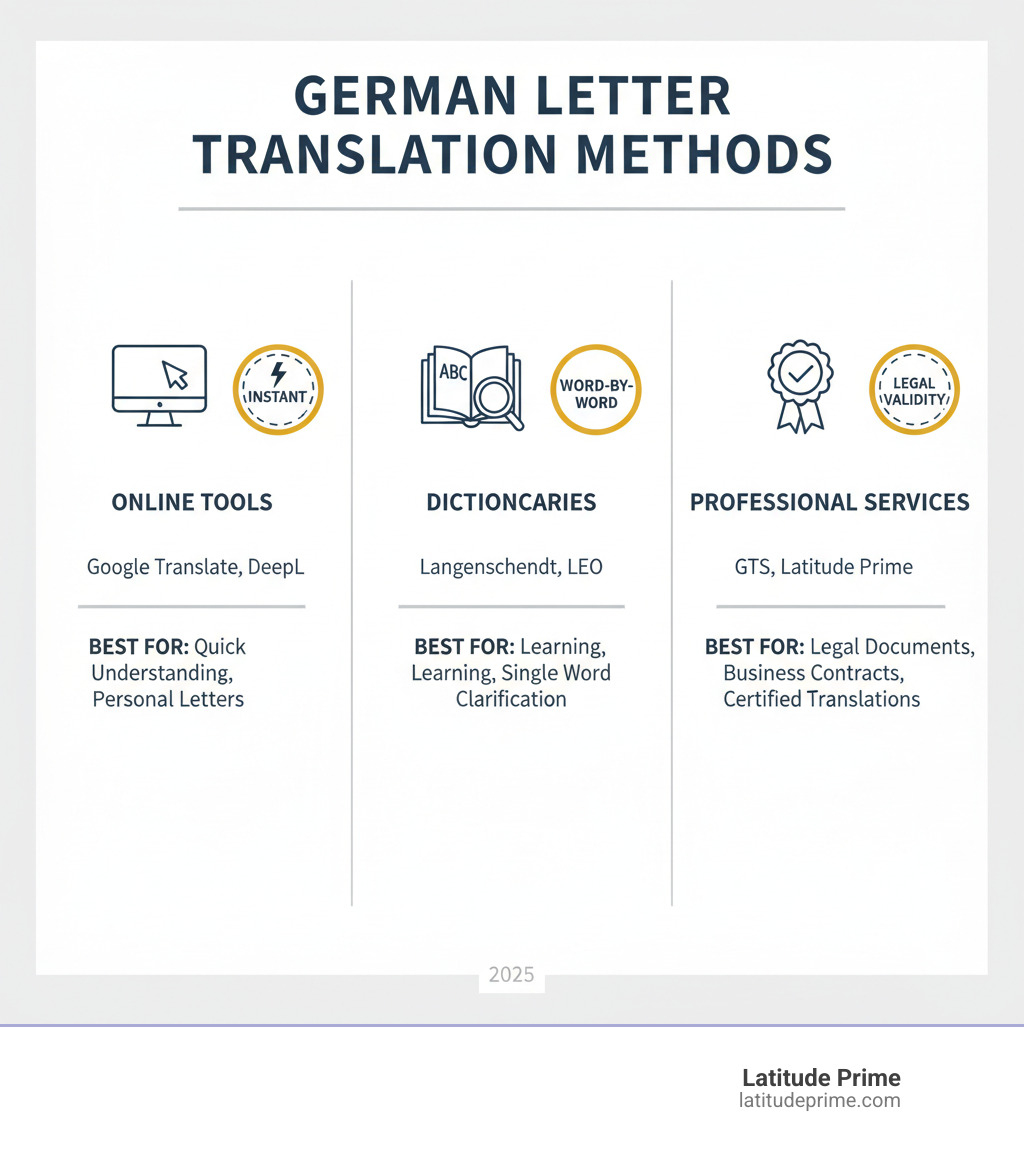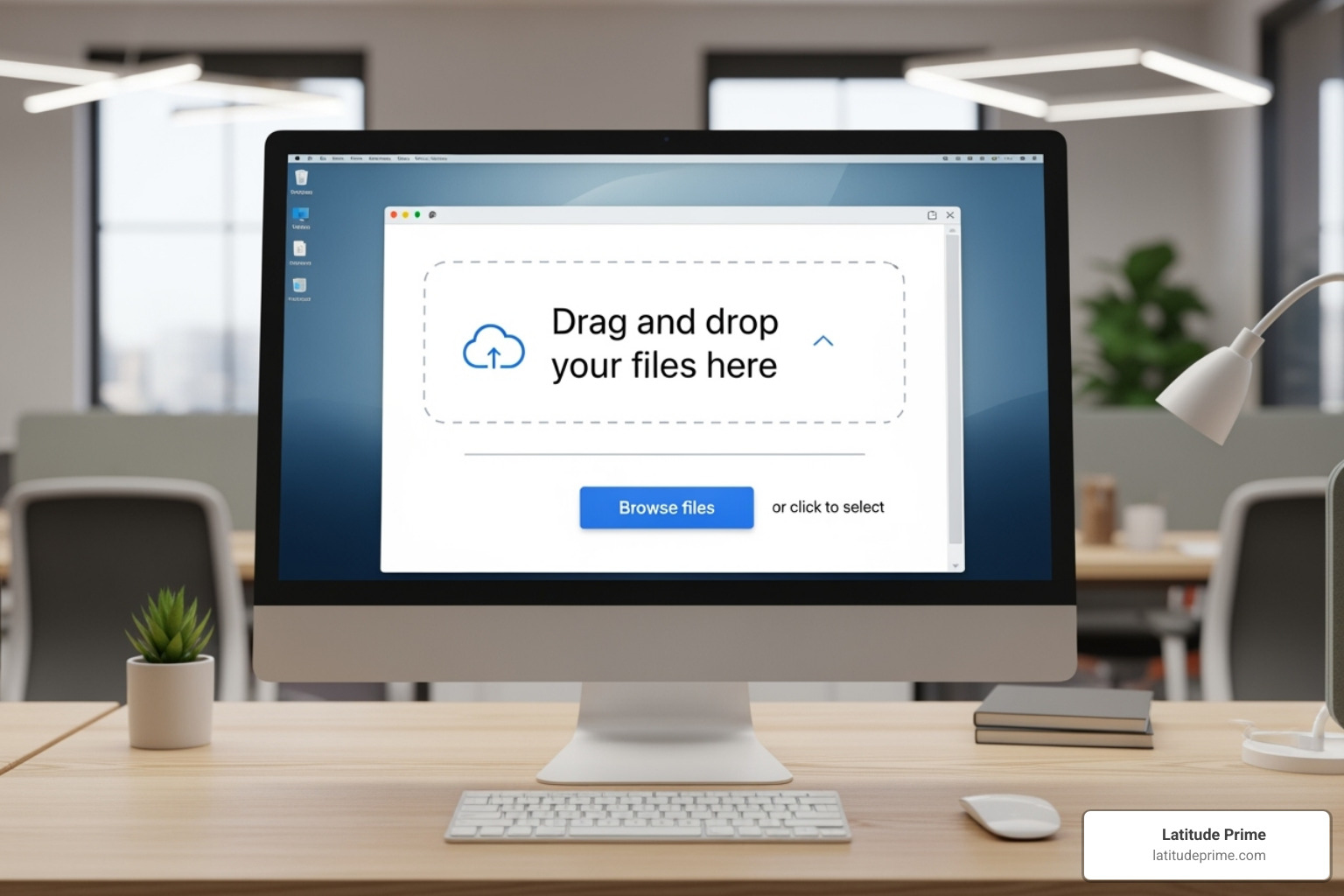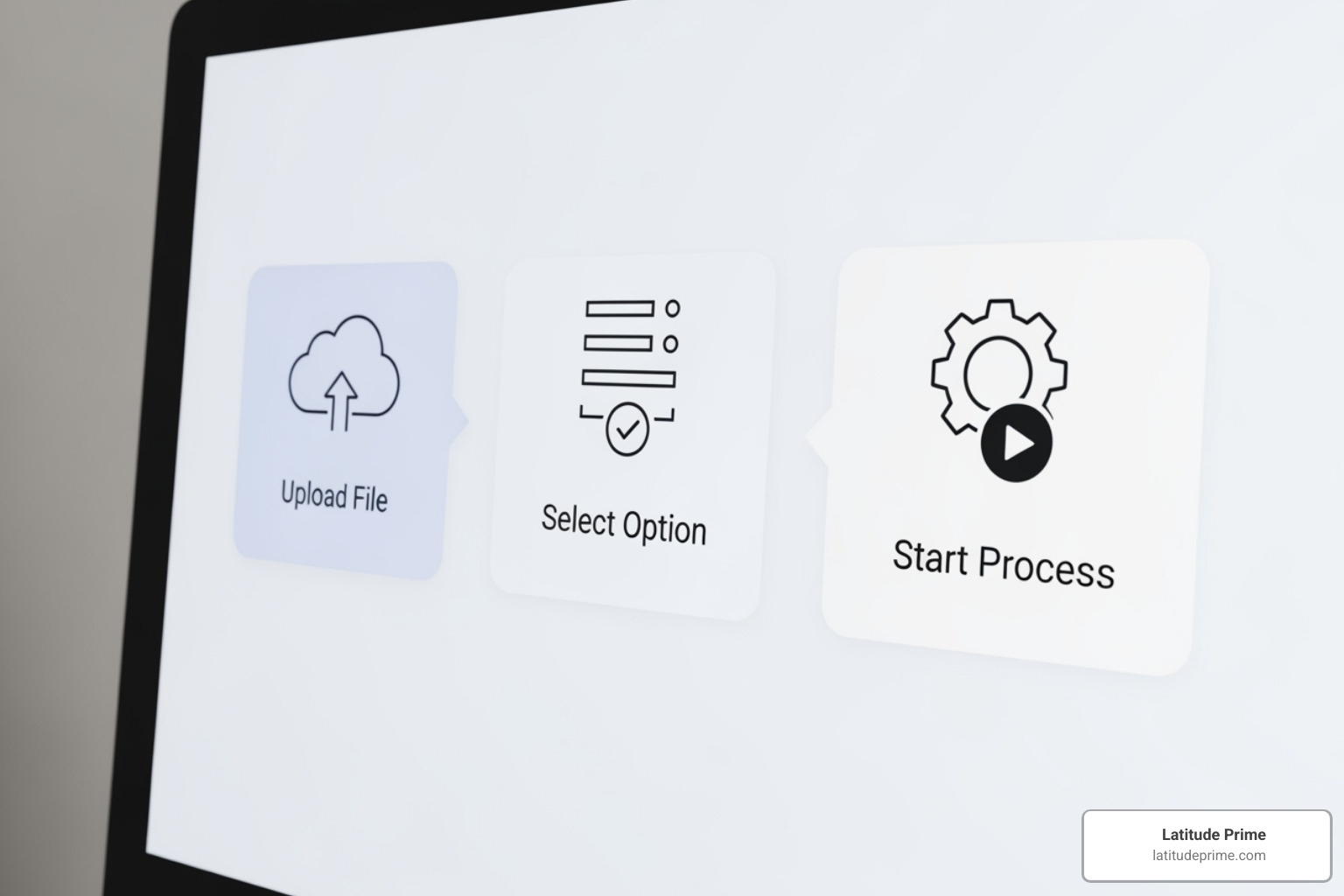Translate German Letter to English: 3 Easy Steps
Why Accurate German Letter Translation Matters
To translate german letter to english, you have three main options:
- Online translation tools for instant, basic understanding.
- German-English dictionaries to clarify specific words or phrases.
- Professional translation services for legal, business, or sensitive documents.
You’ve received a letter in German and need to know what it says, but your German is rusty or nonexistent. The challenge is that German has complex grammar, formal (“Sie”) and informal (“du”) address systems, and cultural nuances that automated tools can miss.
The stakes determine the best method. A quick online tool is fine for a personal note, but a legal document, business contract, or medical report requires precision. A single mistranslation could have serious consequences. With millions of German and English speakers corresponding daily, choosing the right translation method is key to avoiding miscommunication.
This guide will walk you through how to translate your German letter, when to use each method, and how to avoid common errors.

Choosing Your Translation Tool: From Quick Scans to Full Documents
When you need to translate german letter to english, your choice of tool depends on your needs. A free online tool is fine for a casual postcard, but a business contract requires a more robust solution.
Online tools are a common first step for getting the gist of a letter. They are fast and handle many languages. However, how you use them is as important as which one you choose.

Understanding Text vs. Document Translation
There’s a key difference between translating raw text and a full document.
Pasting text is simple: copy the German text, paste it into the tool, and get an instant translation. This is great for short texts where formatting isn’t a concern.
Uploading files is better for letters with headers, signatures, or specific layouts. This document translation feature preserves the visual structure of your file (.docx, .pdf, etc.), so your letterhead and margins stay intact. When formatting matters, uploading the document is the way to go. For help preserving your document’s integrity, check out our document translation services.
Using a German-English Dictionary vs. a General Tool
Sometimes, the best tool isn’t a translator but a dictionary. While general tools provide quick, contextual meaning for whole sentences, they can miss the precise definition of a specific word or idiom.
A dedicated German-English dictionary like this German-English dictionary offers precise, word-for-word lookups. This is invaluable when a machine translation sounds odd, as it can help you find the correct meaning among multiple options. Dictionaries are perfect for:
- Clarifying an ambiguous word.
- Learning vocabulary and grammar.
- Verifying technical jargon or formal terms.
The best approach is often to use both. Use a translation tool for a quick first pass, then use a dictionary to refine key terms and ensure accuracy.
How to Translate a German Letter to English with Online Tools
Using online tools to translate a German letter is straightforward. You can either paste the text directly or upload the entire document to preserve its formatting.

Step 1: Prepare Your German Letter
First, get your letter into a digital format.
- For digital files (.docx, .pdf), you’re ready to go.
- For physical letters, scan them into a high-quality PDF or image file.
- For scanned or image-based text, you’ll need Optical Character Recognition (OCR) to convert the image into editable text. Many translation tools have this feature built-in, allowing you to translate text from an uploaded image or even your phone’s camera.
Be aware that OCR struggles with handwriting and old German scripts (like Sütterlin), which may require professional help.
Step 2: Select and Use Your Translation Tool
Once your letter is digitized, the process is simple:
- Choose your tool and steer to its text or document translation feature.
- Set the languages: German (source) to English (target).
- Input your content: Either copy and paste the text or upload your document file.
- Click “Translate.” The tool will generate the English version, often providing a downloadable file that keeps the original formatting if you uploaded a document.
- Review the output. This is a critical step. Machine translation isn’t perfect. Read the English text and check for awkward phrasing, nonsensical sentences, or errors in tone (e.g., formal vs. informal address). If something seems wrong, it probably is, and may require a dictionary lookup or professional review.
Understanding the Limits: Accuracy, Privacy, and Formatting
Online translation tools are helpful but have limits. When you translate german letter to english, it’s crucial to understand their shortcomings in accuracy, privacy, and formatting.

How accurate are machine translation tools for German to English?
While machine translation has improved, “adequate” isn’t always enough. German poses unique challenges that algorithms often miss:
- Contextual Errors: A word can have multiple meanings, and machines may pick the wrong one for the context.
- Idioms and Culture: German expressions like “Das ist mir Wurst” (literally “that is sausage to me”) mean “I don’t care,” but a machine will translate them literally, causing confusion.
- Formal vs. Informal Address: The choice between “Sie” (formal) and “du” (informal) is vital in German. Automated tools may fail to apply the correct tone consistently.
- Grammar and Nuance: Complex German sentence structures, along with subtle tone and emotion, are often lost in translation.
As we often tell clients, machine translation “is not as reliable as human translation and can also produce incorrect sentences.” For critical documents, accuracy is essential.
Are there privacy concerns when using online translation tools?
Yes. Using free online tools for sensitive information is risky.
- Data Storage: Most free services store your text to improve their algorithms. This means your private business or personal data could be saved on their servers.
- Confidentiality: Without a formal confidentiality agreement, you have no guarantee your information will remain private. This is a major concern for legal, medical, or business documents.
- Compliance: Using these tools could violate data protection regulations like GDPR or HIPAA if the letter contains personal information.
If your letter contains names, financial details, medical information, or trade secrets, a free online tool is not a secure choice. At Latitude Prime, we use strict confidentiality agreements and secure protocols to protect your data. Learn more at our document translation services page.
When to Choose Professional Translation Services
When you need to translate german letter to english for high-stakes situations, free online tools are not enough. For documents that affect your legal, financial, or business standing, professional translation is essential.
This applies to legal documents (contracts, immigration forms), business correspondence (proposals, financial reports), medical records, academic materials, and official certificates (birth, marriage). These require absolute accuracy and often official certification. As an ISO-certified company, Latitude Prime provides translations that meet these standards. Learn more on our German Translation page.
For Official and Legal Correspondence
Legal documents leave no room for error. A single mistake can alter a contract’s meaning or cause an immigration denial. Professional legal translators understand the specific terminology of both German and English legal systems.
This is critical for certified translations, which are required by courts, universities, and government agencies. A certification is a signed statement from the translator or agency attesting to the translation’s accuracy—something an online tool cannot provide. This human oversight ensures your document’s legal validity.
For Sensitive Business and Personal Letters
Professional translation is also vital for confidential or nuanced communications. For business, it’s about protecting relationships and proprietary information. A poorly translated proposal can cost a deal, while a mistranslated HR policy can create liability.
Professional agencies operate under strict confidentiality agreements, ensuring your sensitive data is secure. Human translators also maintain your brand voice and tone, adapting the message to resonate with an English-speaking audience while preserving your original intent. For personal letters with sensitive content, a human translator provides the understanding and nuance that machines lack. In high-stakes communication, professional translation is an investment in clarity.
Tips for Improving Machine Translation Quality
While machine translation isn’t perfect, you can significantly improve its quality. The key is to prepare the source text and carefully review the output.
How can I improve the quality of machine translations from German to English?
- Break down long sentences. German is known for long, complex sentences that confuse translators. Split them into shorter, simpler ones before you translate german letter to english.
- Correct typos. Machine translators are literal. A spelling error in the German text will lead to a translation error. Proofread the original first.
- Use a dictionary for key terms. If a translated word seems odd, use a German-English dictionary to verify its meaning. Machines can pick the wrong definition for words with multiple meanings.
- Use standard language. Avoid heavy slang, dialects, or overly casual phrases, as these can confuse automated tools.
- Review the final output. Post-editing is crucial. Read the English translation and check for awkward phrasing, inconsistent terminology, and incorrect tone (e.g., formal vs. informal). Does it make sense?
- Provide context. For ambiguous words like “Bank” (which can be a financial institution or a river bank), add a clarifying word in the source text to guide the AI.
A little human oversight makes machine translation a much more powerful tool, turning a rough draft into a readable and natural-sounding text.
Frequently Asked Questions about Translating German Letters
Here are answers to common questions about how to translate german letter to english.
What are the key differences between formal and informal German letters?
Understanding formality is crucial in German. The main differences are:
- Salutations: Formal letters use “Sehr geehrte/r Herr/Frau [Last Name],” while informal ones use “Liebe/r [First Name],”.
- Pronouns: Formal correspondence uses the polite “Sie” for “you,” whereas informal letters use the familiar “du.”
- Closings: Formal letters end with “Mit freundlichen Grüßen,” while informal closings include “Viele Grüße” or “Liebe Grüße.”
Machine translation often struggles to maintain the correct level of formality, which is why human expertise is valuable.
Can I translate a handwritten German letter?
Yes, but it’s challenging. You must first scan the letter to create a digital image. Then, you can use an Optical Character Recognition (OCR) tool to convert the image to text. However, OCR accuracy is low for handwriting, especially for old German scripts like Sütterlin or Kurrent. For important or hard-to-read letters, professional transcription is recommended to ensure the German text is accurate before translation.
How much does it cost to translate a German letter to English?
The cost varies by method:
- Free Online Tools: Many popular tools are free for basic understanding but lack accuracy and privacy for official use.
- Professional Services: Pricing is typically per word (e.g., $0.09-$0.35) and depends on complexity, urgency, and volume. Some services charge per page for non-editable files.
- Certification: Certified translations for official use usually have an additional fee.
For a precise quote on your project, contact a professional service like Latitude Prime.
Conclusion: Ensure Your Message is Understood
To translate german letter to english effectively, you must match the method to the stakes. While popular online tools are fine for casual notes, they fall short for important documents.
Machine translation often misses critical nuances like formal vs. informal address, cultural context, and idiomatic expressions. It can give you words, but not always the correct meaning, and it cannot guarantee confidentiality for sensitive information.
Professional translation ensures your message lands exactly as intended. It’s about accuracy, maintaining the proper tone, and meeting legal requirements. It’s the only way to be certain your communication is understood perfectly.
At Latitude Prime, our ISO-certified quality standards and expert human translators provide the precision your German letter deserves. Whether for immigration, business, or personal matters, we ensure your message is clear and secure.
For everything that truly matters, choose professional translation.
Ready to get started? Get a quote for professional document translation and let us ensure your German letter speaks perfect English.




